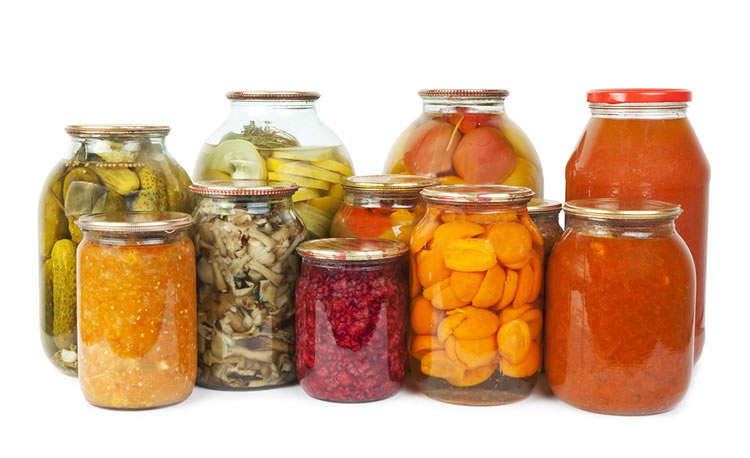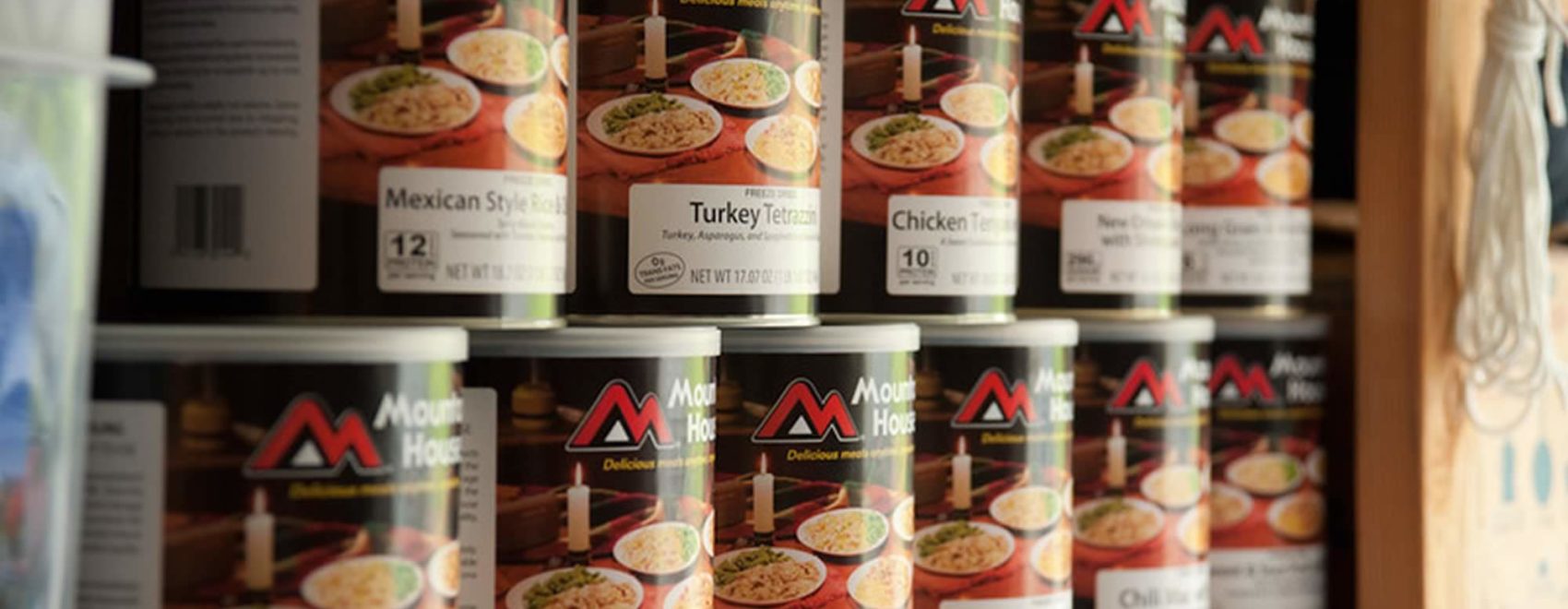Survival Food Storage Shelf Life
What’s the REAL shelf life of survival food

There is a lot of confusion about what exactly “shelf life” means when it comes to long-term food storage. Basically, the shelf life of a product is the amount of time that it can be stored and safely consumed. Once the product is past its shelf life, it may be diminished in taste and quality.
All long-term storage food is processed to remove the water in the food, and then sealed by removing the air and adding an oxygen absorber. Once sealed in a Mylar pouch, the food is considered to be free of bacteria, moisture, and safe from pests.
The shelf life of each product varies, with ration bars and MREs having the shortest life of 3-5 years, followed by “cook in pouch” freeze dried meals which have a 7 – 10 year shelf life. Just about everything else has a 20 – 25 year shelf life. Of course, when in doubt, read the package.
All products must be stored properly in a dry, cool area to minimize exposure to moisture and pests. Your long term food storage supplies should also be rotated so that the food that is nearing the end of its shelf life is eaten first.

An ideal store of emergency food would be made up largely of foods that have a shelf life of 25 years or more. The shorter the shelf life, the more often rotation and replacement are required. Rotation can become an expensive practice and requires a lot of organization to keep on top of. If your food is made up of mostly long-term foods, you can buy it and only have to worry about it a few times in your life.
Keep in mind that most Survival Food companies will claim a 25-year shelf life, but sometimes this is just a number made up for marketing. Be aware of this, and make sure you know the properties of their food that will likely last a long time.
How will you know how long Survival Food should really last? Studies(5) done recently by the Department of Nutrition, Dietetics, and Food Science at Brigham Young University looked at various foods that had been stored for 30 years and examined them for edibility and nutrition after 30 years of storage.
Here are a few of their findings:
Salt, baking soda, baking powder, and granulated sugar, when stored in their original containers and stored properly, have no known shelf life.
Wheat and rice, when stored in cans, foil pouches, or buckets, can last 30+ years. Powdered milk, oats, instant potatoes, dried apples, macaroni pasta, and pinto beans, when stored in a can or foil pouch with oxygen absorber, can last 15-30 years.
Wet-pack canned foods can last a few years, but acidic foods like tomatoes can cause the cans to corrode if stored too long. Foods like yeast and cooking oil will last for a year and a half, and powdered eggs will last one year.
For more helpful information on the shelf life of different foods and ways of packaging, check out BYU’s College of Life Sciences website, which lists all their current research on the subject:
Oxygen is the enemy of shelf life
In order to achieve optimal shelf life, emergency food must have extremely low oxygen levels. Oxygen destroys food storage shelf life because even small amounts can grow bacteria and spoil food.
In general, the residual oxygen level once a food has been packaged should be well below 2 percent. If a Survival Food company will not disclose the levels of oxygen in their food, or if they simply admit that they do not test for oxygen levels, steer clear of that food. If it is not tested for extremely low oxygen, it simply cannot last for the amount of time most companies advertise.
A good thing to watch for is that suppliers use oxygen absorbers in their packaging. Oxygen absorbers can extend shelf life and prevent the growth of aerobic pathogens. Nitrogen flushes are another plus in packaging. Both of these practices used together can eliminate virtually all oxygen. When you are looking for a food storage supplier, make sure they use both of these practices in packaging.
Food storage types compared.
In the wide world of Survival Food options, it’s easy to get overwhelmed. Are cans better, or buckets of bulk grains? Are MREs really a feasible food storage option? What’s all the hype about freeze-dried foods? How do you know which is right for you? As you navigate your options, there are many factors that should weigh in your decision, including the nutritional content maintained by the different types of food storage, the ease of storage and transport, the cost, the shelf-life, the taste, and the ease of preparation.
Bulk grains.
Bulk grains are another very familiar way to store food. Many people like bulk grains because they are a do-it-yourself method of storage. Most bulk grains last a long time (with the exception of brown rice). However, bulk grains can also be inconvenient to store because they typically come in five-gallon buckets and are heavy to lift and move.
They also present a very difficult problem if the emergency situation you find yourself in is one without power (which is fairly common). Without a stove or oven, it is difficult to make bread from your wheat or boil your oats. In this type of situation, you would have food but no way to eat it.
MREs.
Meals ready to eat (MREs) are just what they sound like. They are full- course meals that have everything in one–entree, side dish, dessert, drink, condiments, and often a small heating device. MREs do not require water and are easily the most convenient of the Survival Food options.
Downsides of MREs are that they are often made up of high-fat and high-sodium foods, and they are rumored to have a worse taste than other types of food storage. The biggest disadvantage of MREs is that they have a relatively short shelf-life, usually somewhere around three years.
As far as storage goes, they are bulky and heavy. They are also typically more expensive than other food storage types.
Dehydrated or freeze-dried meals. Another emergency food option is meals that are a combination of dehydrated and freeze-dried food. One of the benefits of these types of foods is that all you have to do is add water (a smaller amount than would be needed to cook them), and the meal is done. In addition, they generally make for good- tasting meals because the freeze-drying process retains all the original flavor and smells of the food in its original state.
The freeze-drying process also allows the food to retain its nutrients and thereby makes it one of the most nutritious options as well. Dehydrated and freeze-dried meals are lightweight and very easy to store because they take up so little space. They are also easy to move and transport in a possible evacuation. Dehydrated and freeze-dried meals are often stored in mylar pouches. It’s a good idea if they are then packaged in buckets to increase air-tightness.
Stackable buckets are nice as opposed to cardboard boxes, which are useless in a flood. The main disadvantage of these types of meals is that you do need to have water to add to them. However, water should be a big part of your emergency preparation anyway, so this is not a big setback.
Check out your options on food storage packaging and decide which is right for you. Many people like to do a combination of the different types of Survival Food, starting with their staples and then filling in the rest as they go. Whichever option you decide to go with, make sure you consider all the factors and make an informed decision.
How to store your food for best results
Once you have gathered your Survival Food, the next step is to know how to store it properly. In order for food storage to last as long as it can, it must be kept away from moisture, oxygen, light, and heat. If you have made the right choices when selecting your food storage products, the first three of these requirements will already be met–your containers will be airtight and will not let in moisture or light.
The last requirement– keeping it away from heat–is up to you.
Store your Survival Food in the coolest place you have. Some possible places might be root cellars, basements, under-the-stairs storage areas, or pantries and closets that are away from heating vents and refrigerators/freezers. What you are going for is a consistently cool and dry place.
If you simply have no other options, you might also consider storing your food in a garage or outdoor shed as long as you remember to move the food to a cooler place during the summer months as these places can get very hot.
Also be sure that your Survival Food supply is away from rodents, insects, and other intruders. Usually, keeping it off the ground is a good way to avoid these pests.

